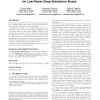Free Online Productivity Tools
i2Speak
i2Symbol
i2OCR
iTex2Img
iWeb2Print
iWeb2Shot
i2Type
iPdf2Split
iPdf2Merge
i2Bopomofo
i2Arabic
i2Style
i2Image
i2PDF
iLatex2Rtf
Sci2ools
GLVLSI
2003
IEEE
2003
IEEE
Combining wire swapping and spacing for low-power deep-submicron buses
We propose an approach for reducing the energy consumption of address buses that targets both the switching and the crosstalk components of power dissipation. The method is based on the combined application of two techniques. First, selective wire swapping is applied in such a way that bus wires with high coupling activity are kept far away from each other. Then, the slack available in the floorplanning for the routing of the bus wire is exploited to realize a bus with non-uniform inter-wire spacing. Both swapping and placement are driven by the switching data obtained from the analysis of typical address bus traces, and can be successfully applied to any address bus. Results on a set of profiled address streams show the effectiveness of the proposed approach. Categories and Subject Descriptors J.6 [Computer Applications]: Computer-Aided Engineering; B.4 [Hardware]: Input/Output and Data Communication; C.3 [Computer Systems Organization]: SpecialPurpose and Application-Based Systems...
Address Bus | Address Bus Traces | Bus Wire | GLVLSI 2003 | VLSI |
| Added | 04 Jul 2010 |
| Updated | 04 Jul 2010 |
| Type | Conference |
| Year | 2003 |
| Where | GLVLSI |
| Authors | Enrico Macii, Massimo Poncino, Sabino Salerno |
Comments (0)

